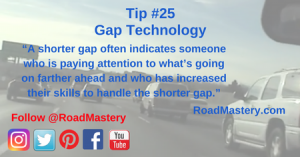This isn’t always true, of course. But for the most part, if handling and ‘reading traffic’ skills hadn’t been increased to the level they were, more than likely they wouldn’t be following at the distance they are. This is true for whatever size of gap a person has.
This does NOT mean that the closer you follow the better! There is an ideal following distance that varies depending on the equipment, the individual, the road conditions, the road design, the traffic flow, etc… and skill level.
But, none the less, virtually every gap can tell you a lot about that individual and more times than not those with shorter gaps are more skilled and aware.
Important Note: Again, to reiterate, ‘looking ahead and reading others properly’ is paramount in order to successfully utilize shorter gaps and still be efficient and safe. Those who don’t read traffic properly, will spend much of their time and energy decelerating and re-accelerating over and over again. And it’s easy to see who they are by observing their timing, ‘reading traffic’ and handling skills in their actions and reactions. (You noticing and learning about these individuals is more of you ‘reading traffic properly’.)
2nd Important Note: There are also people with short gaps who are too close and constantly cross the lines into others’ personal space*. When you see it, read it and learn about that person. And if this describes you (as it has us all on occasion), know that there is a difference in ‘communicating with others’ (we’ll cover communication later) and ‘irritating them’. If you ‘communicate’ without irritating them, they are much more likely to work with you, rather than against you.
*Personal space depends on the individual. What is acceptable to one person may not be acceptable to another. Knowing this is important. Personal space can be partially determined by observing (reading) a person’s skills and confidence. For example, the gap a person has in front of them can tell you about what their ‘comfort zone’ and ‘personal space’ boundaries are.

